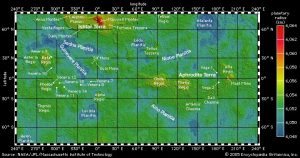Although our immediate neighbor is visible twice a day from Earth, we know little about the planet Venus. It is very difficult to keep a spacecraft on its surface — where the temperature is hot enough to melt lead, and only radar imaging can pierce the fast-swirling clouds that cover the upper atmosphere. However, recent data from the Japanese Aerospace Exploration Agency’s Akatsuki spacecraft has signaled a long-awaited breakthrough in Venus studies.
The Japanese research team was using Akatsuki’s Longwave Infrared Camera (LIR) to record heat patterns in Venus’ atmosphere when the scientists noticed irregularities over some of the largest Venusian mountain ranges. They attributed these results to gravity waves, vertical air disturbances that are common on many planets, including Earth. This finding — which may explain the existence of the clouds that conceal Venus’ surface from our view — also has applications to Earth.
“It is hard to imagine anything more different from our planet,” said Ronald Smith, a professor of Geology & Geophysics at Yale, regarding the Venusian atmosphere. Venus’ three-layer atmosphere, composed mostly of heat-trapping carbon dioxide, is about 100 times as dense as Earth’s — so dense, in fact, that it often acts as a gas and a liquid at the same time. In the highest layer, enigmatic super-rotating sulfurous clouds blow constantly westward faster than Venus spins on its axis.
Gravity waves, not to be confused with gravitational waves (cosmic space-time ripples that were predicted by Einsteinian general relativity and finally detected last year), are common phenomena on Earth. Disturbances caused by triggers in the lower atmosphere — such as thunderstorms, volcanic eruptions, wind passing over mountains, and airplanes — travel upwards into the atmosphere. When a small parcel of air is displaced upwards, it pushes the next parcel up before it is pulled down by gravity, and the ensuing chain reaction can propagate for miles. “These waves oscillate through a balance of buoyancy and gravity,” said Makoto Taguchi, the principal investigator for LIR.

When Akatsuki passed Venus in December 2015, LIR spotted a conspicuous bow-shaped hot patch that remained directly above the prominent Venusian mountain range Aphrodite Terra. This warm region, as well as the fifteen others that the researchers found during the subsequent eight months, indicated a slower-moving air pocket among the otherwise super-rotating clouds. “The stationary thermal structure reminded me of waves on the surface of a shallow river in which a big invisible stone on the bottom prevents the smooth flow of water,” Taguchi said. Since gravity waves travel vertically, they interrupt horizontal airflow — exactly as was observed on Venus. “After thorough theoretical consideration and numerical simulations, we concluded that only a gravity wave could have created the characteristic bow shape,” Taguchi confirmed.
This discovery alters the conversation about the role of gravity waves in maintaining Venus’ unusual atmosphere. “The most tantalizing idea is that these gravity waves carry momentum, and when they break down, they release strong winds, which could explain the mechanism of super-rotation,” said Smith, whose Deep Wave project in 2014 investigated similar phenomena above the New Zealand Alps. Because Venus’ atmosphere thins with altitude, gravity waves that are small at the surface amplify until they finally shatter — like the crack at the end of a whip — and deliver all their stored energy to the upper atmosphere. The behavior of these gravity waves as they cross layers of the Venusian atmosphere also provides indirect information about important characteristics such as temperature profile.
Surprisingly, one of the most far-reaching consequences of the Akatsuki mission may have nothing to do with Venus specifically. LIR’s camera, an uncooled microbolometer array (UMBA), represents a breakthrough in space imaging. Standard cooled semiconductor bolometers, which are common in meteorology and astronomy for measuring slight changes in temperature using infrared radiation, are bulky, heavy, and energy-intensive. UMBA is not dependent upon a cooling apparatus and is thus better suited for spacecraft where compactness is a guiding consideration. “This was the first mission to use UMBA to take a snapshot of a planet,” said Taguchi, who hopes that UMBA will make infrared imaging accessible to a wider variety of space missions.

Understanding Venusian gravity waves is important for many branches of Earth science: the same gravity waves that make for bumpy airplane landings in Denver also factor into cloud movement and carry chemicals from Earth’s surface into the upper atmosphere. Accounting for this variable, however, is still one of the biggest weaknesses of existing climate change and weather models, and any step towards filling this gap is substantial.
